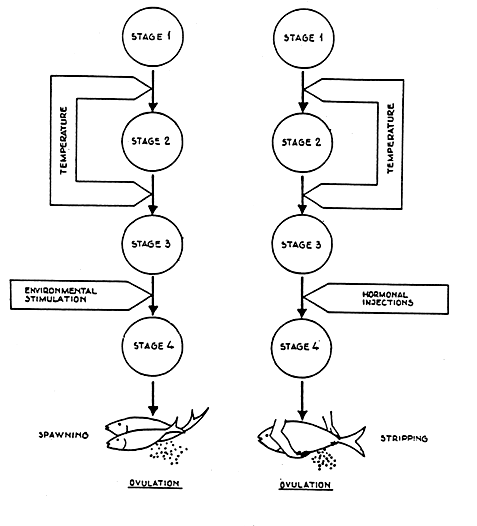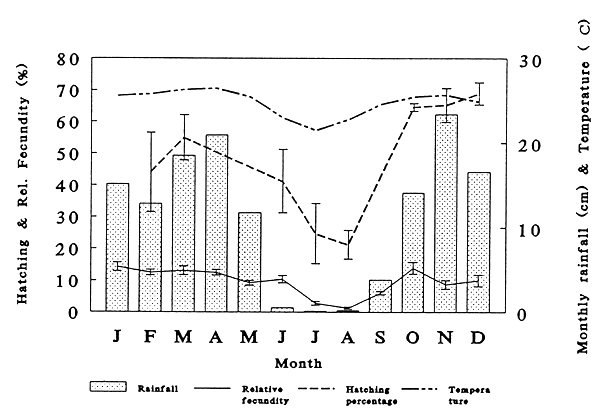The development of the oocytes of the African catfish is mostly related to temperature (as is common with a large number of fish species). Within the development of the oocyte 5 chronological stages can be seen (see figure 2);
| STAGE 1: | Pre-vitello genesis2 stage or primary oocytes. The oocyte are small (7–10 micron) and are not yet containing yolk. The number of primary oocytes increases through mitotic division and at the end of this stage the oocytes increase its size to approximately 200 micron. |
| STAGE 2: | Endogenous vitello genesis stage. Within this stage the yolk of the oocyte (the future reserve/feed for the just hatched larvae) is formed. The origin of the yolk in this stage is the oocyte itself. |
| STAGE 3: | Exogenous vitello genesis. The oocyte increases to its final size of 1000–1200 micron (1–1.2 mm). During this phase yolk formation in the oocyte increases and the origin of the proteins needed for this process is outside the oocyte (the liver). A large nucleus (0.2 mm) is clearly visible a little outside of the centre of the oocyte. The oocytes in this stage are also called “ripe eggs”. They remain in this stage until environmental factors (rainfall and water level rise or a hormonal injection) let them ovulate. |
| STAGE 4: | Ovulated eggs. Either through natural or artificial processes (the administration of hormones) the oocytes will be ovulated or liberated from the ovarian tissue. During the process of ovulation the yolk accumulates into one droplet, consequently the eggs becomes transparent and the nucleus migrates completely to the outer-side (animal pole) of the egg. |
| STAGE 5: | Atretic eggs. Eggs which are not well ovulated will be re-absorbed (or recycled) again by the fish and they can distinguished by their “flushy” appearance. |
2 Vitellogenesis is the process of yolk forming
The development from stage 1 to stage 3 is related to temperature (and of course age when first maturation is considered). This development process will take place once the water temperatures are 20–22 °C or higher. After ovulation of the “ripe eggs” the majority of the oocytes found in the ovary consists again of stage 1 oocytes, the cycle is repeated and after approximately six weeks a new batch of “ripe eggs” is ready for ovulation.
| Figure 2 | NATURAL REPRODUCTION | ARTIFICIAL REPRODUCTION |

As explained in 3.1. the African catfish has a fully developed ovary which contains “ripe” eggs the whole year through once the water temperature remains above 22 °C. The eggs of a “ripe” female make up 15–20% of the body weight (e.g. a “ripe” female of 1 kg has 150–200 gram of “ripe” eggs).
The oocyte development decreases (consequently also percentage of eggs of the female) once the temperature drops below 22 °C as can be seen from the results obtained in Congo-Brazzaville (see figure 3). In June-July-August the water temperature drops below 22 °C and we see that the ovary makes up approximately 5 % of the body weight of the female. Artificial reproduction is still possible but the number of egg obtained is small and the quality of the eggs decreases as can be seen from the decreased hatching percentage.
Figure The relative fecundity (% of total body weight), hatching percentage (% of total eggs) of Clarias gariepinus, average monthly rainfall (cm) and average air-temperature (°C) measured in Brazzaville, bars indicate S.E.M.
